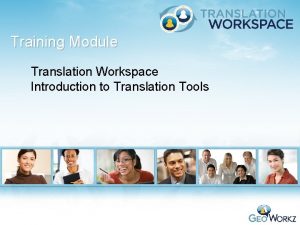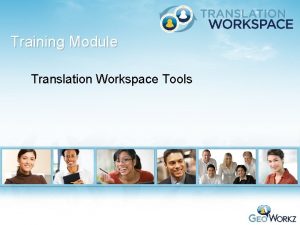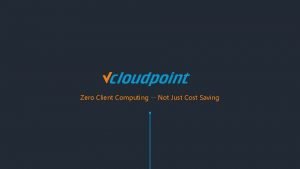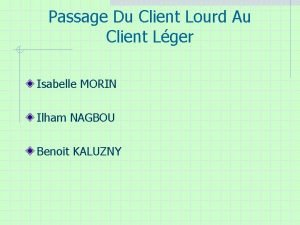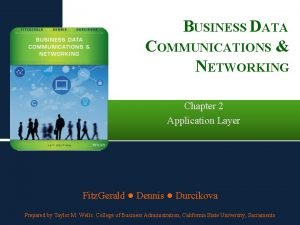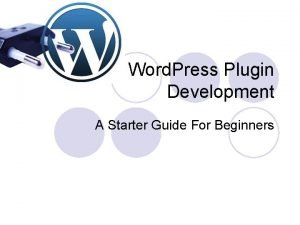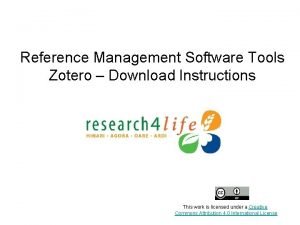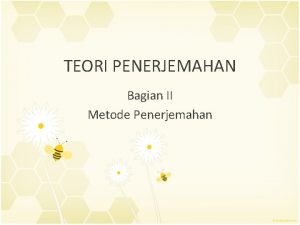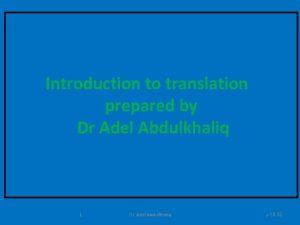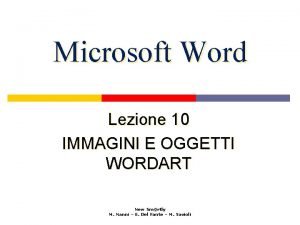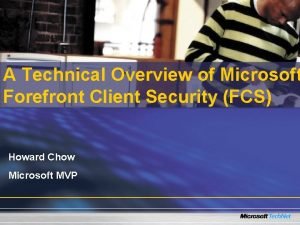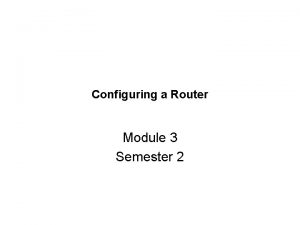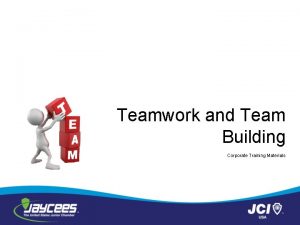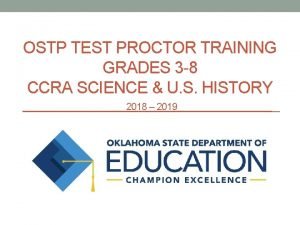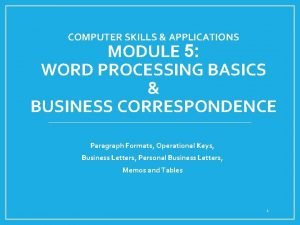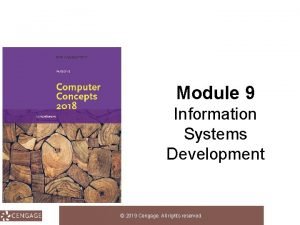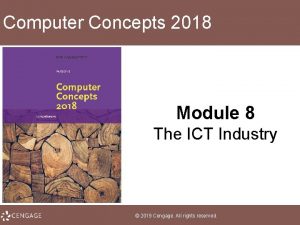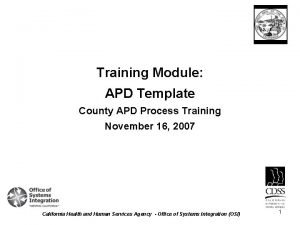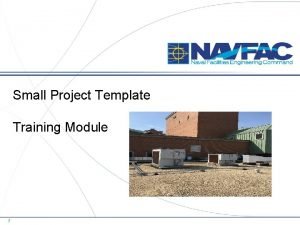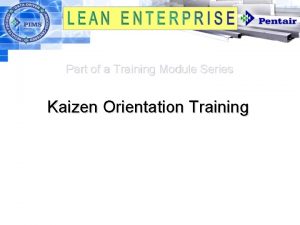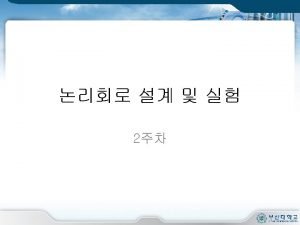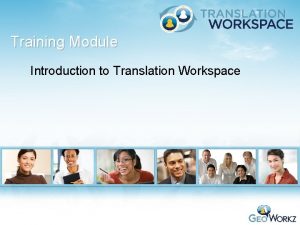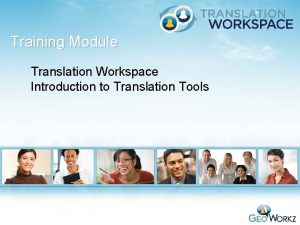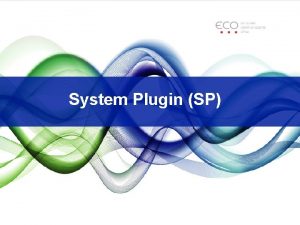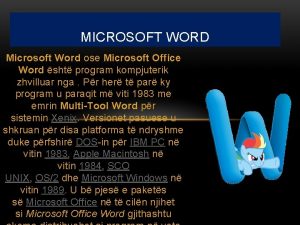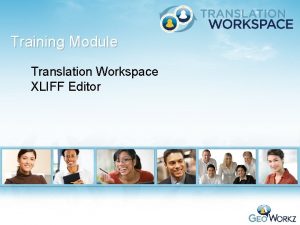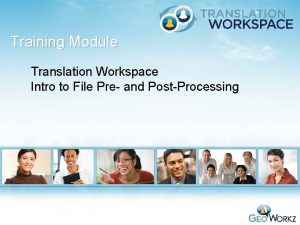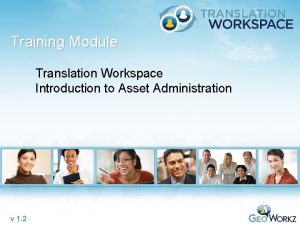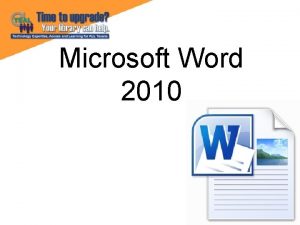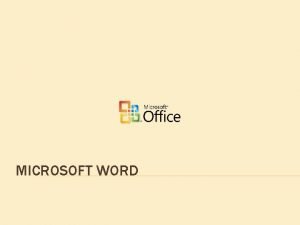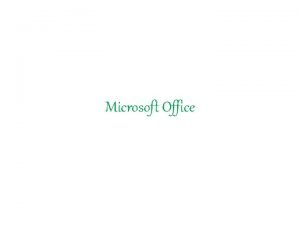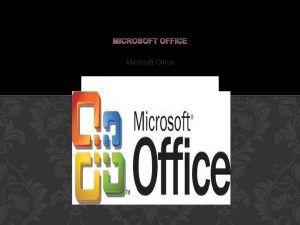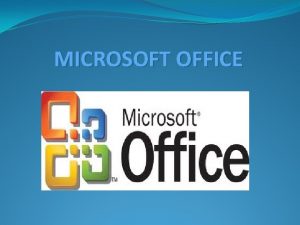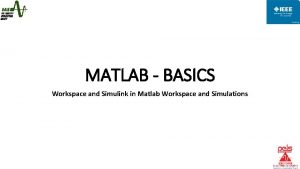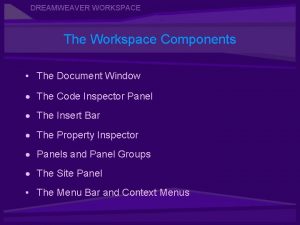Training Module Translation Workspace Client Microsoft Word Plugin
































- Slides: 32

Training Module Translation Workspace Client Microsoft Word Plug-in 1

Training Module Overview Course Objective: This course provides information on the installation, user interface and use of the translation client within Microsoft Word. Upon course completion, you will be a confident user of the Translation Workspace Client – Microsoft Word Plug-in. Duration: 90 minutes Prerequisites: • Introduction to Translation Tools Suggested Subsequent Training: • • • 2 Translation Workspace Client – XLIFF Editor Translation Workspace Tools Introduction to File Pre- and Post-Processing Copyright 2010 Geo. Workz

Learning Agenda 1. Introduction • Installation, Access, and Configuration • User Interface 2. Conducting the Translation • • • Opening files Common Translation Functions Understanding Match Rates Working with Tags and Special Characters Terminology & Concordance Search Post-Translation Functions 3. Advanced Functions • XML/HTML Preview • Merging/Splitting Segments • Chat 3 Copyright 2010 Geo. Workz

Definition of Terms • CAT: Computer Aided Translation Workspace is a CAT Tool • Segment: Often a sentence, heading, or list item. • Segmenting: The process of dividing the translatable text into Segments • Translation Unit: A source and Target segment pair in the database • Live Assets. TM: Data is hosted on a server and is updated realtime as users interact with it • Asset Aliasing. TM: The process of sharing Live Assets across tenancies 4 Copyright 2010 Geo. Workz

Definition of Terms • Linking: Connecting linguistic assets to form a group that can be referenced simultaneously • Source (string/segment): Original language (string/segment) in TM or translatable file • Target (string/segment): Target language (string/segment) in TM or translatable file • Match: The percentage of similarity between one segment and another • Context match (101% match): A 100% match with the same surrounding segments as when it was originally translated and saved to the TM. • Concordance match: Contains some partial phrases from the searched segment, but the words may be in a different order. 5 Copyright 2010 Geo. Workz

Introduction Microsoft Word Plug-in • The Microsoft Word Plug-in is compatible with several versions of Microsoft Word, including 2000, 2002, 2003, and 2007 • The Word Plug-in provides a working environment that is familiar for most professional translators • The Word Plug-in is suggested for translating files where the source is. RTF, . DOC, or non pre-segmented. TTX • For more information, refer to the "Filter Usage" training or the "Introduction to Pre and Post Processing" training. File Format File Extension Recommended Filter Recommended Client Rich text format RTF Translation Workspace RTF Word Plug-in Microsoft Word 2000 -2003 DOC, DOT Translation Workspace RTF Word Plug-in Trados S-tag TTX to RTF Word Plug-in 6 Copyright 2010 Geo. Workz

Introduction Installing Microsoft Word Plug-in • To install the Microsoft Word Plug-in, a licensed version of Microsoft Word is required • Download the Word Client Plug-in from Translation Workspace, or the Support page of Geo. Workz. com • The Microsoft Word Client Plug-in installer also includes Translation Workspace Tools. More information about Translation Workspace Tools is available in the "Translation Workspace Tools" training. • Close Microsoft Word before beginning the installation • Double-click the executable to start the installation wizard and select the configuration suited to your needs 7 Copyright 2010 Geo. Workz

Introduction User Interface • The installation of the Microsoft Word Plug-In creates an entry on the Microsoft Word Menu/Ribbon • The user interface will differ depending on which version of Microsoft Word you have installed, but the icons are the same • Through the menu you can access sub-menus and short-cut keys • In Word 2003, the Toolbar provides access to frequently used commands • The Microsoft Word Plug-in offers the following functions: • • • 8 Translation options Terminology options Tag options Pre and Post-Processing TM Management Search, Chat, and Help Copyright 2010 Geo. Workz

Introduction User Interface Each of the icons below is common across all Word Plug-in installations, although they will appear in different locations. 9 Copyright 2010 Geo. Workz

Introduction Microsoft Word Configuration • Configuring Microsoft Word Settings • Adjusting some Microsoft Word settings prior to using the Translation Workspace Client Word Plug-in makes translating easier and prevents possible conflicts with other software • To adjust the settings at least one Microsoft Word file must be open • For best results • Use the Normal view • Use "Show all" hidden text and formatting elements To access Microsoft Word Settings: • In Word 2003: Go to Tools > Options > View • In Word 2007: Go to the Office Button > Word Options > Display 10 Copyright 2010 Geo. Workz

Introduction Microsoft Word Plug-in Configuration • Adjusting the Translation Workspace Client Settings defines the features of the translation user interface • Always disable other CAT tool plug-ins prior to launching the Microsoft Word Plug-in • Establish the Translation Workspace connection to modify settings • Some of the options impact usability • Select your preferred options prior to starting work • You may also make changes to the settings while working • Common Settings include: • • • 11 Update Screen while Batch Processing: Off Terminology Window always on Top: On Allow connection optimization: On Color Coding: On Protect Tags: On Copyright 2010 Geo. Workz

Learning Agenda 1. Introduction • Installation, Access, and Configuration • User Interface 2. Conducting the Translation • • • Opening files Common Translation Functions Understanding Match Rates Working with Tags and Special Characters Terminology & Concordance Search Post-Translation Functions 3. Advanced Functions • XML/HTML Preview • Merging/Splitting Segments • Chat 12 Copyright 2010 Geo. Workz

Conducting a Translation Opening Files • For best results, use pre-processed RTF files • Open Microsoft word, then More information available in "Introduction to Pre- and Post open the file - Processing" • A file that is prepared (pre-processed) for translation has been marked with specific character styles • Translatable text is in the “normal” style and appears black. • Non-translatable text is marked with one of three styles: • Logoport. Tag (violet) for Segment delimiters and match percent indicators • Logoport. Do. Not. Translate (gray) for Non-translatable strings outside segments (tags & other non-translatables) • Logoport. Markup (red) for Tags, entities and other non-translatables inside segments Non-translat_txt outside_sentences<tag>lpt_dw_xyz <tag> (-: Original <tag> segment</tag> comes first. )=0%(Target <tag> segment </tag> includes the translation. : -)<tag>lpt_grf_ dw_xyz<tag>Any_other_nontranslatable_text<tag> 13 Copyright 2010 Geo. Workz

Conducting a Translation Selecting the TM • Before beginning to translate, login to Translation Workspace • Selecting a translation option automatically opens the login window • You can also connect to the server by using the Connect icon • Login to Translation Workspace using your Username, Password, Tenancy, and Server Address (translate. translationworkspace. com) • If you require a proxy address, your system administrator will have this information • After login, you are presented with a list of Translation Memories • Your translations will be stored to the selected TM • Next, you must select the Source Language and Target Languge 14 Copyright 2010 Geo. Workz

Conducting a Translation Working with Segmentation • Translatable text is often segmented based on normal punctuation, including • Paragraph mark • Combination of: Full stop + Space + Capital letter • Translation Workspace segments text during translation with segment separators (-: Source text)=0%(Target text: -) • Translate one segment at a time • A fully translated document has all translatable text in pairs Non-translat_txt outside_sentences<tag>lpt_dw_xyz <tag> (-: Original <tag> segment</tag> comes first. )=0%(Target <tag> segment </tag> includes the translation. : -)<tag>lpt_grf_ dw_xyz<tag>Any_other_nontranslatable_text<tag> 15 Copyright 2010 Geo. Workz

Conducting a Translation Commonly used Translation Functions • The commands commonly used during translation appear in the Translation, Terminology, and Tags sections in the Word 2007 ribbon • Translation • • • Open Next Untranslated Segment (Ctrl+Alt+Home) is used to open the next available segment for translation Translate to Next non-100% match (Ctrl+Shift+* (on the Number Pad)) increases productivity by translating 100% matches in the document Store, Close and Open Next Segment (Alt+ + (on the Number Pad)) saves the open segment to the TM and opens the next available segment • Terminology • Get Current Term (Alt+Down Arrow) adds the currently selected term in the Auto. Terminology window to the document being translated • Tags • 16 Get Current Tag (Alt+Ctrl+Down Arrow) adds the currently selected tag of the source text into the same location in the target text Copyright 2010 Geo. Workz

Conducting a Translation Viewing the segments Bilingual segments, containing both source and translated text, are stored in the RTF. The translated text is visible. The original source text and the tagging syntax are marked as hidden text. Show/hide hidden text (source language text & tagging syntax) 17 Copyright 2010 Geo. Workz

Conducting a Translation Understanding Match Rates During translation, the match rate from the TM is displayed above the source segment. Referenced TM Date and Time 93% UI_Project_TM jdoe 8/1/2009 04: 40: 22 AM Match rate User (or tenant) If background TMs are in use, the match rate will show the premium or penalty applied, along with the name of the TM in which the segment appears. When multiple matches are available, the relative match rate of the previous and next match are shown. 93+3% 88%> UI_Legacy_TM 1 ada 8/1/2008 02: 12: 45 PM Next available match 93 -5% <96% 85%> UI_Legacy_TM 2 jdoe 8/1/2005 06: 15: 11 AM Previous available match 18 Copyright 2010 Geo. Workz

Conducting a Translation Open Segment • When a segment is open, there are three boxes visible. 1. The top box contains the match information and the source segment found in the TM. 2. The second box contains the source segment from the document being translated. 3. The third box contains the target segment found in the TM. • To navigate through the available segments, use • Get Next Match (Alt+Ctrl+Shift+Right Arrow), and • Get Previous Match (Alt+Ctrl+Shift+Left Arrow). • Differences between the segment in the document and the TM are highlighted. 19 Copyright 2010 Geo. Workz

Conducting a Translation Working with Tags and Special Characters • A Placeable is a non-translatable string inside a segment, for example: <strong> • To copy the placeable tags from the source to the target segment, use the Get Current Tag (Alt+Ctrl+Down Arrow) command • When there are multiple tags within the source segment, use the Get Next Tag (Alt+Ctrl+Right Arrow) • The placeable is inserted at the cursor position • Another type of placeable are elements, such as numbers, or acronyms. • Special Characters may appear in the segment, for example: ' • The characters may require editing, or may be treated as placeables • Use caution modifying special characters, as the pre-conversion process should modify all translatable entities to normal characters, and the postconversion process returns those characters to entities 20 Copyright 2010 Geo. Workz

Conducting a Translation Using Glossaries • Automatic matching • The Auto. Terminology window displays term matches for the currently open segment from glossaries linked to the translation TM • To add the term to the target segment, use the Get Current Term (Alt+Down Arrow) command The currently selected term in the Auto. Terminology window is inserted at the cursor • Manual search • Click Search a Term to search linked glossaries manually • Fuzzy matching can be used in manual search 21 Copyright 2010 Geo. Workz

Conducting a Translation Concordance Search • There are times when the TM settings will present no matches • By using the Concordance Search, you can check the TM for components of the segment • Use concordance search, when. . . • • • 22 The TM does not provide a match The glossary does not provide a glossary match To check whether a part of the segment has been translated already Copyright 2010 Geo. Workz

Conducting a Translation Using the QA tools To use QA Tools to identify errors in a translated file: 1. Open "Quality Assurance Tools" under Current Document. 2. Select the TM and languages 3. Select the Tests to run 4. Indicate where to save the report 5. Click "Start" The resulting report provides details on issues, like • Missing tags • Formatting inconsistencies • Untranslated segments • Improper cleaning For more information, see the "XLIFF Editor", or "Translation Workspace Tools" training courses. 23 Copyright 2010 Geo. Workz

Conducting a Translation Storing to the TM Translation Workspace is designed to work best when translation are stored to the TM interactively (during translation). Alternatively, the "Clean to Target Language" function can add the translations from one or more files to the TM, while also creating a target language copy of the file(s). 1. View both source and target by toggling "Show/Hide" 2. Select "Clean to target language" 3. In the "Document Cleanup" dialog, specify a log file, identify the files to be cleaned 4. Enable "Create. bak copies of input files" (to avoid overwriting the bilingual file), enable "Store Translations to TM" and click "Cleanup" 24 Copyright 2010 Geo. Workz

Conducting a Translation Back-Conversion To back convert a RTF file into its original file format using the Microsoft Word Plug-in, follow these three steps: 1. Be sure the files have been cleaned and you have saved a copy. 2. Run Back Convert from Current Document or Documents. 3. If converting multiple documents, select the appropriate files and character entities. 25 Copyright 2010 Geo. Workz

Learning Agenda 1. Introduction • Installation, Access, and Configuration • User Interface 2. Conducting the Translation • • • Opening files Common Translation Functions Understanding Match Rates Working with Tags and Special Characters Terminology & Concordance Search Post-Translation Functions 3. Advanced Functions • XML/HTML Preview • Merging/Splitting Segments • Chat 26 Copyright 2010 Geo. Workz

Advanced Functions Pre-translation segment locking • Pre-translation is used to populate the document with translations from the TM. • When conducting a pre-translation of the prepared file, if the option to lock the 100% or 101% matches is selected, the resulting document will appear with the segments of the corresponding match rate highlighted in grey. • It is possible to edit these segments, but the Open Segment command will not work. 27 Copyright 2010 Geo. Workz

Advanced Functions Target File Preview Files can be previewed during translation by using Current Document > Preview as HTML. • Preview works with XML, HTML, MIF, DOCX, PPTX, and INX source files. Configure Preview: Pre-configure your preview settings for the currently open file. Working Folder: The root path containing the RTF files to translate. Context Folder: Location containing support files (graphics, style sheets, etc. ). External Viewer: The application used to preview the target file. • • 28 Copyright 2010 Geo. Workz

Advanced Functions Merging and Splitting Segments • Segmentation is applied to the file during the preparation process based on the TM settings • Text formatted with Logoport. Do. Not. Translate style is always left outside segments as this indicates a split of the storage of the segment • Full strings that should be left in the source language can also use Logoport. Do. Not. Translate style • While translating, make exeptions to the segmentation by • Merging segments to one segment • Splitting a merged segment returns the segment to where auto-segmentation would naturally divide the segments. You may not merge segments with external tags between them 29 Copyright 2010 Geo. Workz

Advanced Functions Chat Use Translation Workspace Chat functionality by selecting "Open Translation Workspace Chat" Communicate in real-time with: • Group: Online users working in the same TM • Same Languages: Online users working in the same TM and language pair • Personal: A specific online user 30 Copyright 2010 Geo. Workz

Summary • The Word Plug-in is suggested for translating files where the source is. RTF, . DOC, or non pre-segmented. TTX • A licensed version of Microsoft Word is required to install the Microsoft Word Plug-in • Comprehensive functionality includes: • • TM leverage and auto-translation Terminology and Concordance searches Chat Preview and Quality Assurance checks • For more information, refer to the Word Plug-in Help. 31 Copyright 2010 Geo. Workz

Additional Training We suggest the following training modules: • Translation Workspace Client – XLIFF Editor • Translation Workspace Tools • Introduction to File Pre- and Post-Processing More information available at http: //geoworkz. com/Support/Training. aspx 32 Copyright 2010 Geo. Workz
 Translation workspace word client
Translation workspace word client Translation workspace tutorial
Translation workspace tutorial Microsoft official academic course microsoft word 2016
Microsoft official academic course microsoft word 2016 Microsoft official academic course microsoft word 2016
Microsoft official academic course microsoft word 2016 Zero client vs thin client
Zero client vs thin client Client léger client lourd
Client léger client lourd Application layer
Application layer Word plugin development
Word plugin development Zotero word plugin download
Zotero word plugin download Contoh free translation
Contoh free translation Surah baqarah word to word translation
Surah baqarah word to word translation Method of translation
Method of translation English to arabic translation
English to arabic translation Word art microsoft office
Word art microsoft office Forefont client security
Forefont client security C device module module 1
C device module module 1 Difference between communicative and semantic translation
Difference between communicative and semantic translation Cisco voice translation rule
Cisco voice translation rule Function transformations
Function transformations Noun phrase example
Noun phrase example Mitel connect training
Mitel connect training What is microsoft wireless router module
What is microsoft wireless router module Corporate training materials
Corporate training materials Iec and bcc difference
Iec and bcc difference Ostp test
Ostp test Hbyc programme
Hbyc programme Word processing packages
Word processing packages Module 10 computer concepts exam
Module 10 computer concepts exam Module 8 computer concepts skills training
Module 8 computer concepts skills training 8 step training model powerpoint
8 step training model powerpoint Training module template
Training module template Training module design template
Training module design template Kaizen training module
Kaizen training module
